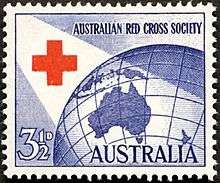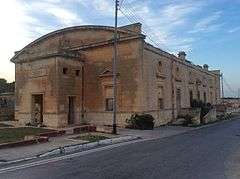Australian Red Cross
 | |
| Motto | The power of humanity |
|---|---|
| Formation | 1914 |
| Type | Non-governmental organisation |
| Legal status | Incorporated by royal charter, 28 June 1941.[1] |
| Purpose | Humanitarian aid |
| Headquarters | Melbourne, Victoria |
Region | Australia |
| Services | |
|
Governor-General of Australia General Sir Peter Cosgrove | |
| Judy Slatyer | |
| Affiliations | International Red Cross and Red Crescent Movement |
| Mission | To be a leading humanitarian organisation in Australia, improving the lives of vulnerable people through services delivered and promotion of humanitarian laws and values |
| Website |
redcross |
Formerly called | British Red Cross Australian Branch |

The Australian Red Cross is a leading humanitarian aid and community services charity in Australia. Tracing its history back to 1914 and being incorporated by royal charter in 1941, the Australian Red Cross Society is the Australian National Society of the International Federation of Red Cross and Red Crescent Societies and part of the International Red Cross and Red Crescent Movement.
The Australian Red Cross provides a range of services and programmes including international aid across the Asia-Pacific region, the advocacy of international humanitarian law, migration support, emergency management, blood donation, and community services for Aboriginal and Torres Strait Islander peoples, youth, families, the elderly, and persons with disabilities.
His Excellency General The Honourable Sir Peter Cosgrove AK, MC, Governor-General of Australia, is the Patron of the Australian Red Cross Society and a non-voting member of the National Council. The National Council is the peak governance decision-making body and is made up of 53 voting members including the President and the National Board. The National Council delegates operational and management decisions and other responsibilities to the National Board and the CEO.[2]
History
A branch of the British Red Cross was established in Australia in 1914, nine days after the start of World War I, by Lady Helen Munro Ferguson. The British Red Cross Australian Branch changed its name to the Australian Red Cross Society and was incorporated by royal charter on 28 June 1941.

The organisation grew at a rapid rate. Lady Helen wrote to the mayors of every shire and municipality in Australia asking them to initiate a local branch. Typically, a letter was published in the local newspaper and a meeting called. By November 1914, New South Wales had 88 city or suburban branches and 249 country branches, all established within the previous four months. The Society was accepted by the community from the beginning. Much of the World War I home front activities such as knitting socks and rolling bandages was done by local Red Cross branches. The Red Cross Information Bureau was established in 1915 in order to coordinate information gathered on the dead and their burial beyond what was provided by the armed forces. The Red Cross Wounded and Missing files were extensive with searchers sometimes sent overseas to clarify information, make better judgements and to resolve conflicting accounts.[3] In 1916 the Australian Red Cross Society sent a team of 21 civilian nurses to France; these nurses were dubbed the "Bluebirds" in reference to the colours of their specially-designed uniforms.[4]
During World War II the Red Cross provided assistance to the sick, wounded, maimed and their dependents.[5] By agreement with the federal government they provided hostel accommodation to those with no living relatives or friends to support them upon returning home from war.[6] At the time the majority of the volunteers were unemployed married women. High rates of membership in the organisation were attributed to their annual, national, recruitment drive.[5] Membership grew from 260,000 in 1941 to 450,00 in 1944. The Australian Red Cross proved to be an important link between the public and Japanese prisoners of war.[5]
In 2005, the organisation made an agreement with the Maldives Government to help clear debris created by the 2004 Indian Ocean earthquake and tsunami.[7] In December 2010, aid workers from the Australian Red Cross were sent to Christmas Island to assist the survivors of the 2010 Christmas Island boat disaster.[8] Australian Red Cross volunteers were also active after Cyclone Tracy hit Darwin, the Ash Wednesday bushfires, the Black Saturday bushfires and the 2010–2011 Queensland floods.[9]
Movement
The Australian Red Cross is part of the International Red Cross and Red Crescent Movement, the largest humanitarian movement in the world. The movement comprises over 97 million volunteers worldwide and prides itself on being neutral, impartial and independent.
Volunteers
The passion and commitment of the volunteers is widely acknowledged. They rise to natural disaster or personal crisis from bushfire to flood or drought. Today there are more than 60,000 trained volunteers and the entire Australian Red Cross program is funded by public donations and corporate partnerships.
Priorities
The eight priority areas of Red Cross in Australia are:
- Strengthening national emergency preparedness, response and recovery
- Increasing international aid and development
- Strengthening communities in areas of locational disadvantage
- Championing international humanitarian law(IHL or ‘the laws of war’)
- Addressing the impact of migration
- Partnering with Aboriginal and Torres Strait Islander peoples
- Overcoming social exclusion by providing bridges back into the community
- Provide a safe, secure supply of blood and blood products - through the Australian Red Cross Blood Service
References
- ↑ "Australian Red Cross royal charter of incorporation" (PDF). Australian Red Cross. Retrieved 18 September 2016.
- ↑ "Governance". Australian Red Cross. Retrieved 16 April 2013.
- ↑ Jalland, Patricia (2006). Changing Ways of Death in Twentieth Century Australia: War, Medicine and the Funeral Business. UNSW Pres. p. 64. Retrieved 16 April 2013.
- ↑ Hetherington, Les (January 2009). "The Bluebirds in France". Wartime. 45: 58–60.
- 1 2 3 Oppenheimer, Melanie (2008). Volunteering: Why We Can't Survive Without it. UNSW Press. pp. 43–47. ISBN 1742240437. Retrieved 16 April 2013.
- ↑ Twomey, Christina (2007). Australia's Forgotten Prisoners: Civilians Interned by the Japanese in World War Two. Cambridge University Press. p. 147. ISBN 0521612896. Retrieved 16 April 2013.
- ↑ Mark Colvin (17 May 2005). "Australian Red Cross to clean up Maldives". PM. Australian Broadcasting Corporation. Retrieved 16 April 2013.
- ↑ Phillips, Brenda D.; David M. Neal; Gary R. Webb (2011). Introduction to Emergency Management. CRC Press. p. 408. ISBN 1439830703. Retrieved 16 April 2013.
- ↑ "History". Australian Red Cross. Retrieved 16 April 2013.
External links
| Wikimedia Commons has media related to Red Cross in Australia. |